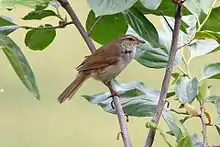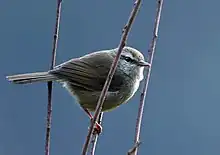Horornis
Horornis is a genus of small insectivorous songbirds ("warblers") which make up the core of the newly recognized family Cettiidae. They were formerly placed in the Sylviidae, which at that time was a wastebin taxon for the warbler-like Sylvioidea. The range of this genus occurs from southeast Asia throughout the western Pacific. The most recently described species is the Bougainville bush warbler (Horornis haddeni) from Bougainville Island.
| Horornis | |
|---|---|
 | |
| The brown-flanked bush warbler (Horornis fortipes) | |
| Scientific classification | |
| Domain: | Eukaryota |
| Kingdom: | Animalia |
| Phylum: | Chordata |
| Clade: | Dinosauria |
| Class: | Aves |
| Order: | Passeriformes |
| Family: | Cettiidae |
| Genus: | Horornis Hodgson, 1845 |
| Type species | |
| Horornis fortipes Hodgson, 1845 | |
| Species | |
|
See text | |
These typical bush warblers share the lifestyle and related adaptations and apomorphies with Bradypterus, the other genus called bush warblers. However, Bradypterus is related to the grass warblers of Locustella and Megalurus and is more distant from Cettia. Both "bush warbler" genera are smallish birds well adapted to climbing among shrubbery. They are markedly long-tailed birds, at first glance somewhat reminiscent of wrens.
These are quite terrestrial birds, which live in densely vegetated habitats such as thick forest and reedbeds. They will walk away from disturbance rather than flush. The plumage similarities and skulking lifestyle makes these birds hard to see and identify.
These bush warblers tend towards rich or greyish browns above and buffish or light grey tones below. They have little patterning apart from the ubiquitous supercilium. Altogether, they appear much like the plainer species among Acrocephalus marsh warblers in coloration. Megalurid bush warblers tend to be somewhat slimmer and have a very long and pointed tail, but are otherwise very similar.
Species
This genus has been split from the genus Cettia. Cetti's warbler (C. cetti), the previous type species, seems close to the genus Tesia from Southeast Asia and neighboring regions. Birds in the genus Horornis, such as the famous uguisu (鶯, Japanese bush warbler, H. diphone) and the brown-flanked bush warbler (H. fortipes) belong to a group that might include the aberrant broad-billed warbler (Tickellia hodgsoni). This latter species differs wildly in its gaudy colors but in habitus is a typical "bush warbler".[1]
| Image | Common Name | Scientific name | Distribution |
|---|---|---|---|
 | Manchurian bush warbler | Horornis canturians | northeastern China. |
.JPG.webp) | Japanese bush warbler | Horornis diphone | Japan |
| Philippine bush warbler | Horornis seebohmi | Philippines. | |
| Palau bush warbler | Horornis annae | Palau. | |
| Shade bush warbler | Horornis parens | Solomon Islands | |
| Bougainville bush warbler | Horornis haddeni | Bougainville Island in the Solomon Islands, Papua New Guinea | |
| Fiji bush warbler | Horornis ruficapilla | Fiji. | |
| Tanimbar bush warbler | Horornis carolinae | Yamdena | |
 | Brown-flanked bush warbler | Horornis fortipes | South Asia |
.jpg.webp) | Aberrant bush warbler | Horornis flavolivacea | southern China, and the northern extremes of Myanmar and Vietnam |
| Yellow-bellied bush warbler | Horornis acanthizoides | mainland China and Taiwan | |
.jpg.webp) | Hume's bush warbler | Horornis brunnescens | Himalayas of Nepal and India. |
Footnotes
- Alström et al. (2006), Fuchs et al. (2006)
References
- Alström, P.; Ericson, P.G.P.; Olsson, U. & Sundberg, P. (2006): Phylogeny and classification of the avian superfamily Sylvioidea. Mol. Phylogenet. Evol. 38(2): 381–397. doi:10.1016/j.ympev.2005.05.015 PMID 16054402 PDF fulltext
- del Hoyo, Josep; Elliott, Andrew & Sargatal, Jordi (eds.) (2006): Handbook of Birds of the World (Volume 11: Old World Flycatchers to Old World Warblers). Lynx Edicions, Barcelona. ISBN 84-96553-06-X
- Fuchs, J.; Fjeldså, J.; Bowie, R.C.K.; Voelker, G. & Pasquet, E. (2006): The African warbler genus Hyliota as a lost lineage in the Oscine songbird tree: Molecular support for an African origin of the Passerida. Mol. Phylogenet. Evol. 39(1): 186–197. doi:10.1016/j.ympev.2005.07.020 (HTML abstract)